wheel NISSAN PATHFINDER HYBRID 2015 Owners Manual
[x] Cancel search | Manufacturer: NISSAN, Model Year: 2015, Model line: PATHFINDER HYBRID, Model: NISSAN PATHFINDER HYBRID 2015Pages: 524, PDF Size: 6.49 MB
Page 3 of 524
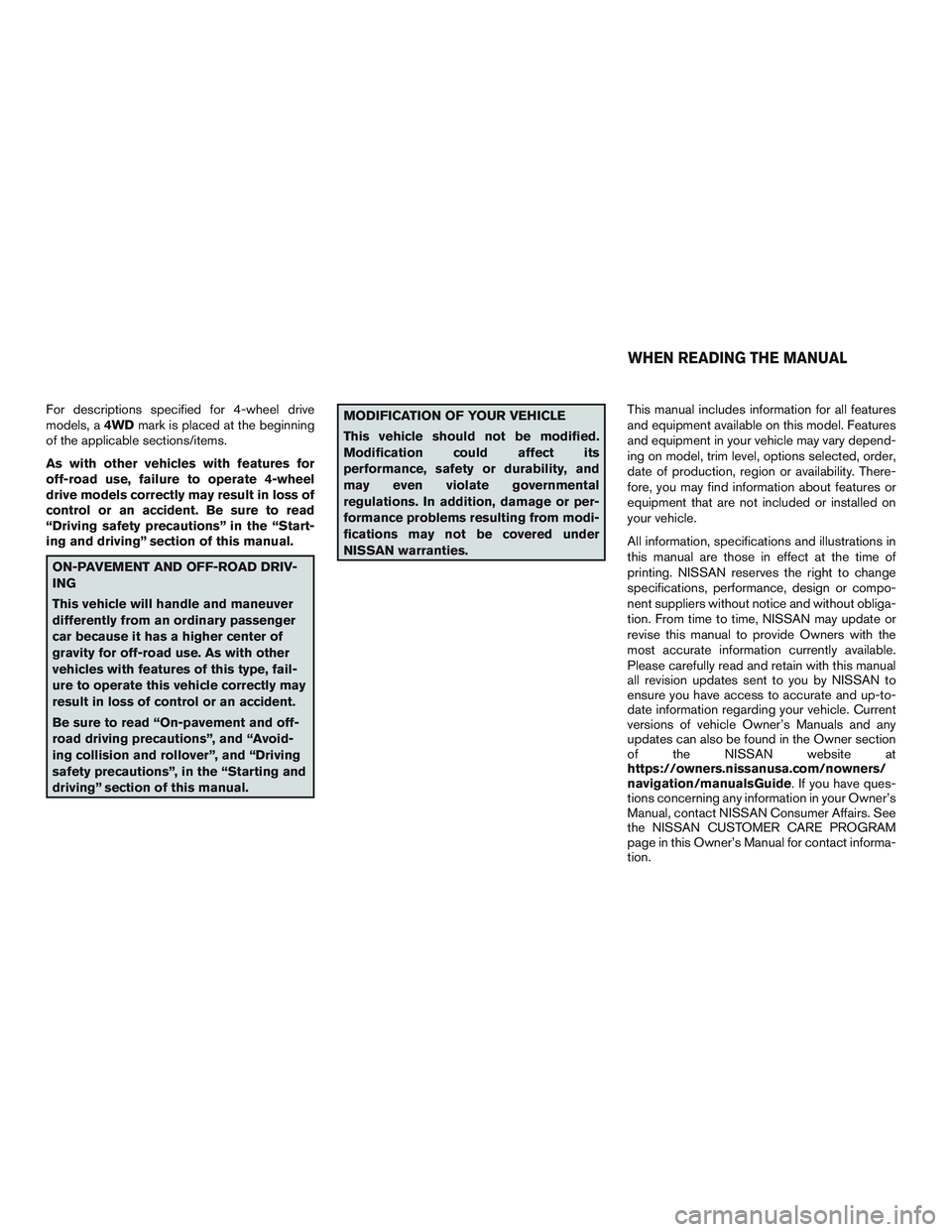
For descriptions specified for 4-wheel drive
models, a4WDmark is placed at the beginning
of the applicable sections/items.
As with other vehicles with features for
off-road use, failure to operate 4-wheel
drive models correctly may result in loss of
control or an accident. Be sure to read
“Driving safety precautions” in the “Start-
ing and driving” section of this manual.
ON-PAVEMENT AND OFF-ROAD DRIV-
ING
This vehicle will handle and maneuver
differently from an ordinary passenger
car because it has a higher center of
gravity for off-road use. As with other
vehicles with features of this type, fail-
ure to operate this vehicle correctly may
result in loss of control or an accident.
Be sure to read “On-pavement and off-
road driving precautions”, and “Avoid-
ing collision and rollover”, and “Driving
safety precautions”, in the “Starting and
driving” section of this manual.
MODIFICATION OF YOUR VEHICLE
This vehicle should not be modified.
Modification could affect its
performance, safety or durability, and
may even violate governmental
regulations. In addition, damage or per-
formance problems resulting from modi-
fications may not be covered under
NISSAN warranties.This manual includes information for all features
and equipment available on this model. Features
and equipment in your vehicle may vary depend-
ing on model, trim level, options selected, order,
date of production, region or availability. There-
fore, you may find information about features or
equipment that are not included or installed on
your vehicle.
All information, specifications and illustrations in
this manual are those in effect at the time of
printing. NISSAN reserves the right to change
specifications, performance, design or compo-
nent suppliers without notice and without obliga-
tion. From time to time, NISSAN may update or
revise this manual to provide Owners with the
most accurate information currently available.
Please carefully read and retain with this manual
all revision updates sent to you by NISSAN to
ensure you have access to accurate and up-to-
date information regarding your vehicle. Current
versions of vehicle Owner’s Manuals and any
updates can also be found in the Owner section
of the NISSAN website at
https://owners.nissanusa.com/nowners/
navigation/manualsGuide. If you have ques-
tions concerning any information in your Owner’s
Manual, contact NISSAN Consumer Affairs. See
the NISSAN CUSTOMER CARE PROGRAM
page in this Owner’s Manual for contact informa-
tion.
WHEN READING THE MANUAL
Page 11 of 524
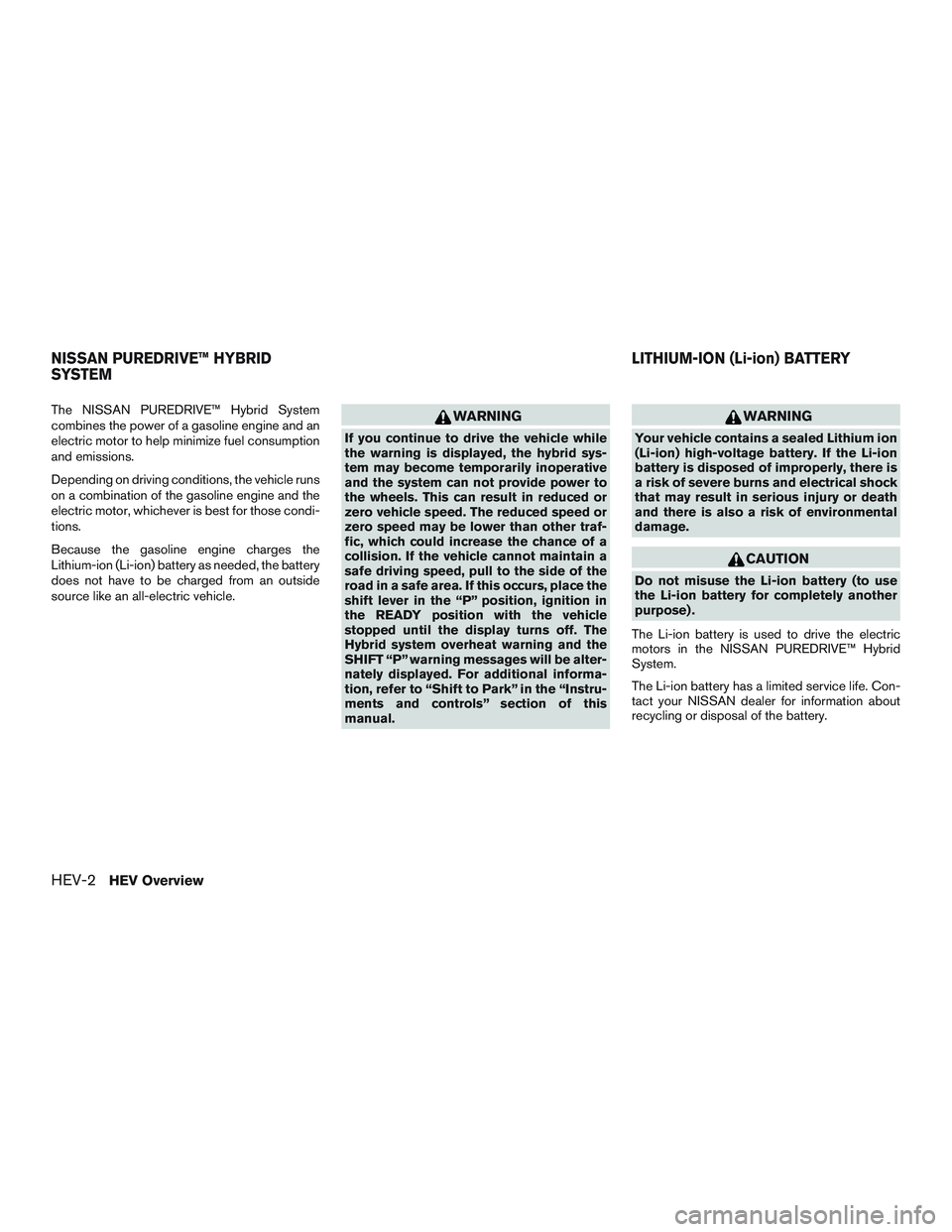
The NISSAN PUREDRIVE™ Hybrid System
combines the power of a gasoline engine and an
electric motor to help minimize fuel consumption
and emissions.
Depending on driving conditions, the vehicle runs
on a combination of the gasoline engine and the
electric motor, whichever is best for those condi-
tions.
Because the gasoline engine charges the
Lithium-ion (Li-ion) battery as needed, the battery
does not have to be charged from an outside
source like an all-electric vehicle.WARNING
If you continue to drive the vehicle while
the warning is displayed, the hybrid sys-
tem may become temporarily inoperative
and the system can not provide power to
the wheels. This can result in reduced or
zero vehicle speed. The reduced speed or
zero speed may be lower than other traf-
fic, which could increase the chance of a
collision. If the vehicle cannot maintain a
safe driving speed, pull to the side of the
road in a safe area. If this occurs, place the
shift lever in the “P” position, ignition in
the READY position with the vehicle
stopped until the display turns off. The
Hybrid system overheat warning and the
SHIFT “P” warning messages will be alter-
nately displayed. For additional informa-
tion, refer to “Shift to Park” in the “Instru-
ments and controls” section of this
manual.
WARNING
Your vehicle contains a sealed Lithium ion
(Li-ion) high-voltage battery. If the Li-ion
battery is disposed of improperly, there is
a risk of severe burns and electrical shock
that may result in serious injury or death
and there is also a risk of environmental
damage.
CAUTION
Do not misuse the Li-ion battery (to use
the Li-ion battery for completely another
purpose) .
The Li-ion battery is used to drive the electric
motors in the NISSAN PUREDRIVE™ Hybrid
System.
The Li-ion battery has a limited service life. Con-
tact your NISSAN dealer for information about
recycling or disposal of the battery.
NISSAN PUREDRIVE™ HYBRID
SYSTEMLITHIUM-ION (Li-ion) BATTERY
HEV-2HEV Overview
Page 14 of 524
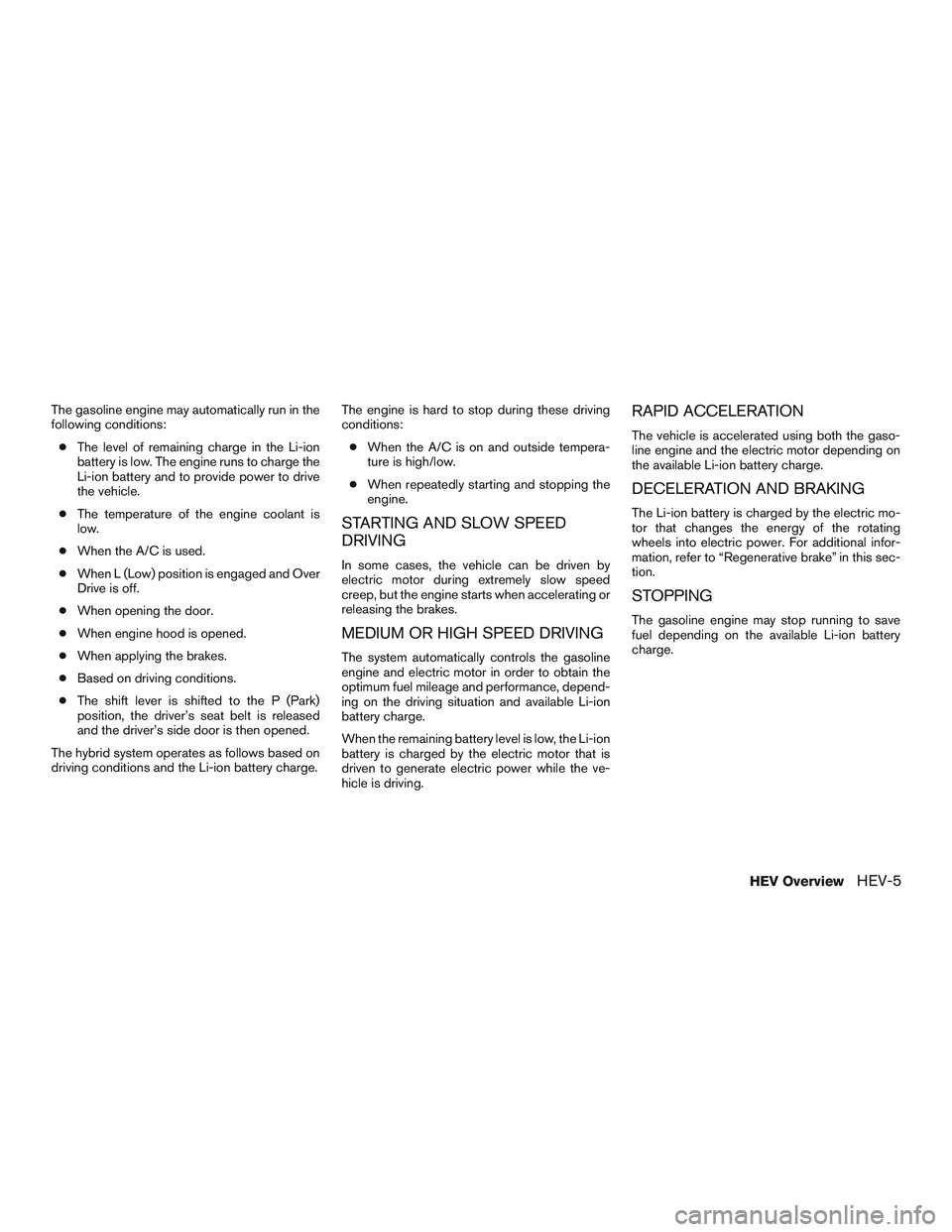
The gasoline engine may automatically run in the
following conditions:
●The level of remaining charge in the Li-ion
battery is low. The engine runs to charge the
Li-ion battery and to provide power to drive
the vehicle.
●The temperature of the engine coolant is
low.
●When the A/C is used.
●When L (Low) position is engaged and Over
Drive is off.
●When opening the door.
●When engine hood is opened.
●When applying the brakes.
●Based on driving conditions.
●The shift lever is shifted to the P (Park)
position, the driver’s seat belt is released
and the driver’s side door is then opened.
The hybrid system operates as follows based on
driving conditions and the Li-ion battery charge.The engine is hard to stop during these driving
conditions:
●When the A/C is on and outside tempera-
ture is high/low.
●When repeatedly starting and stopping the
engine.
STARTING AND SLOW SPEED
DRIVING
In some cases, the vehicle can be driven by
electric motor during extremely slow speed
creep, but the engine starts when accelerating or
releasing the brakes.
MEDIUM OR HIGH SPEED DRIVING
The system automatically controls the gasoline
engine and electric motor in order to obtain the
optimum fuel mileage and performance, depend-
ing on the driving situation and available Li-ion
battery charge.
When the remaining battery level is low, the Li-ion
battery is charged by the electric motor that is
driven to generate electric power while the ve-
hicle is driving.
RAPID ACCELERATION
The vehicle is accelerated using both the gaso-
line engine and the electric motor depending on
the available Li-ion battery charge.
DECELERATION AND BRAKING
The Li-ion battery is charged by the electric mo-
tor that changes the energy of the rotating
wheels into electric power. For additional infor-
mation, refer to “Regenerative brake” in this sec-
tion.
STOPPING
The gasoline engine may stop running to save
fuel depending on the available Li-ion battery
charge.
HEV OverviewHEV-5
Page 19 of 524
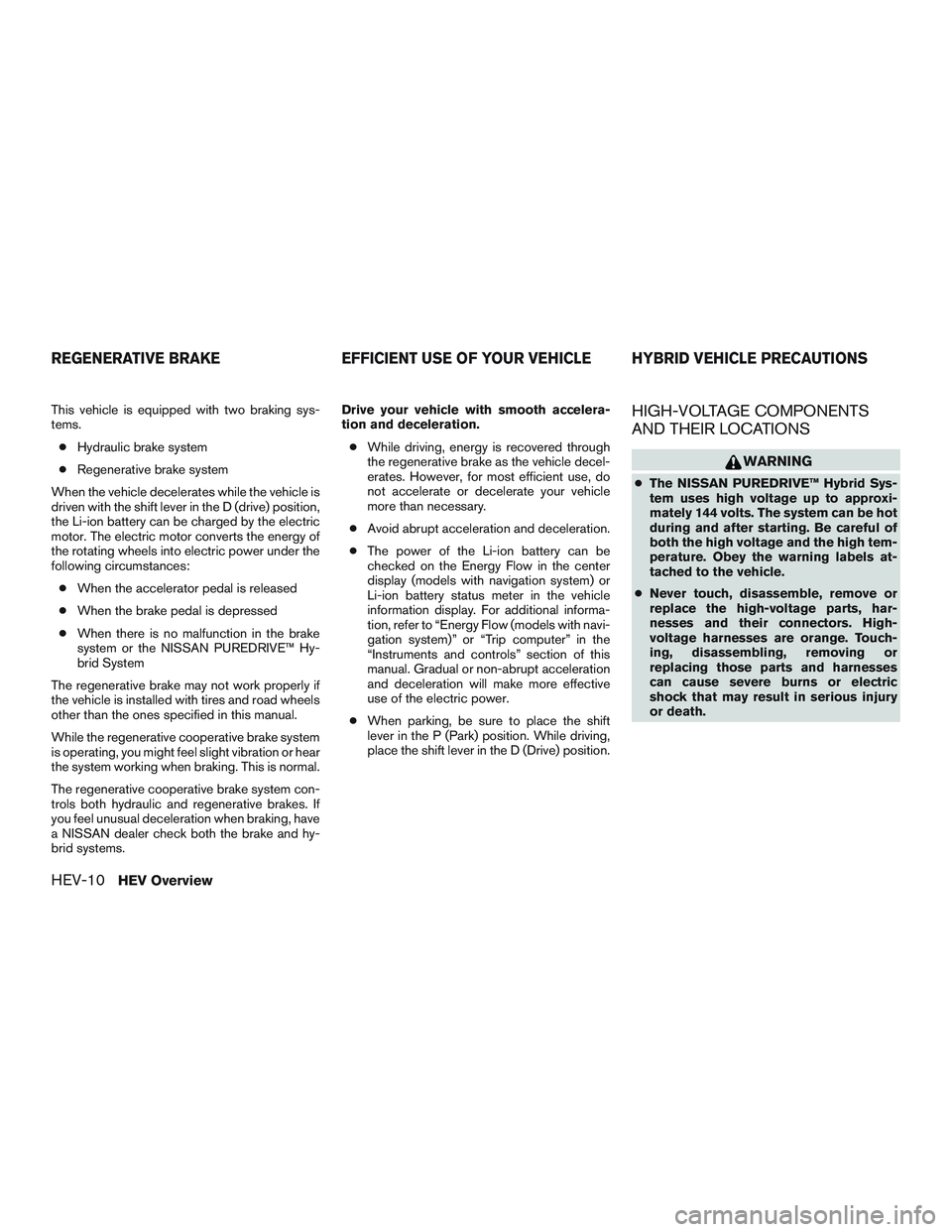
This vehicle is equipped with two braking sys-
tems.
●Hydraulic brake system
●Regenerative brake system
When the vehicle decelerates while the vehicle is
driven with the shift lever in the D (drive) position,
the Li-ion battery can be charged by the electric
motor. The electric motor converts the energy of
the rotating wheels into electric power under the
following circumstances:
●When the accelerator pedal is released
●When the brake pedal is depressed
●When there is no malfunction in the brake
system or the NISSAN PUREDRIVE™ Hy-
brid System
The regenerative brake may not work properly if
the vehicle is installed with tires and road wheels
other than the ones specified in this manual.
While the regenerative cooperative brake system
is operating, you might feel slight vibration or hear
the system working when braking. This is normal.
The regenerative cooperative brake system con-
trols both hydraulic and regenerative brakes. If
you feel unusual deceleration when braking, have
a NISSAN dealer check both the brake and hy-
brid systems.Drive your vehicle with smooth accelera-
tion and deceleration.
●While driving, energy is recovered through
the regenerative brake as the vehicle decel-
erates. However, for most efficient use, do
not accelerate or decelerate your vehicle
more than necessary.
●Avoid abrupt acceleration and deceleration.
●The power of the Li-ion battery can be
checked on the Energy Flow in the center
display (models with navigation system) or
Li-ion battery status meter in the vehicle
information display. For additional informa-
tion, refer to “Energy Flow (models with navi-
gation system)” or “Trip computer” in the
“Instruments and controls” section of this
manual. Gradual or non-abrupt acceleration
and deceleration will make more effective
use of the electric power.
●When parking, be sure to place the shift
lever in the P (Park) position. While driving,
place the shift lever in the D (Drive) position.HIGH-VOLTAGE COMPONENTS
AND THEIR LOCATIONS
WARNING
●The NISSAN PUREDRIVE™ Hybrid Sys-
tem uses high voltage up to approxi-
mately 144 volts. The system can be hot
during and after starting. Be careful of
both the high voltage and the high tem-
perature. Obey the warning labels at-
tached to the vehicle.
●Never touch, disassemble, remove or
replace the high-voltage parts, har-
nesses and their connectors. High-
voltage harnesses are orange. Touch-
ing, disassembling, removing or
replacing those parts and harnesses
can cause severe burns or electric
shock that may result in serious injury
or death.
REGENERATIVE BRAKE EFFICIENT USE OF YOUR VEHICLE HYBRID VEHICLE PRECAUTIONS
HEV-10HEV Overview
Page 29 of 524
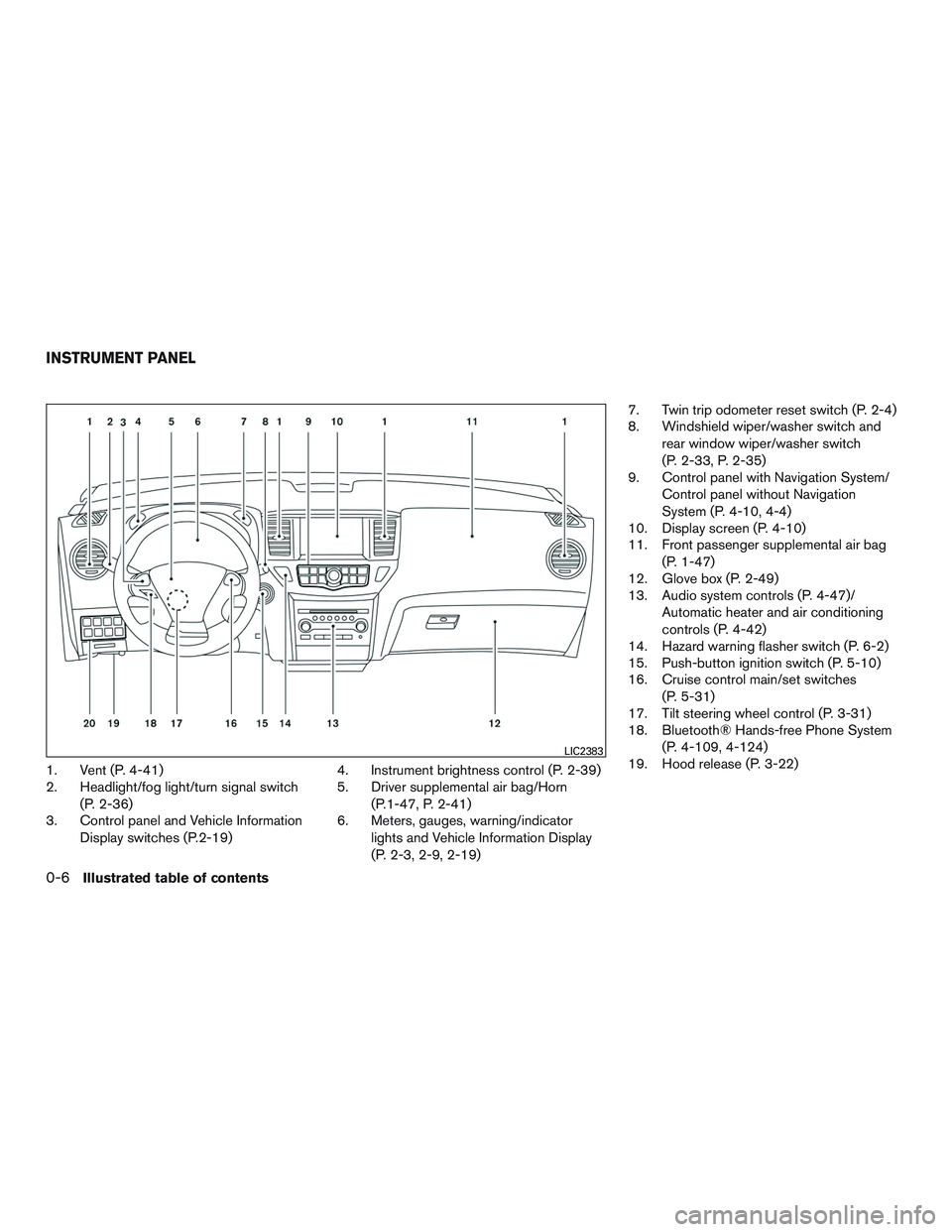
1. Vent (P. 4-41)
2. Headlight/fog light/turn signal switch
(P. 2-36)
3. Control panel and Vehicle Information
Display switches (P.2-19)4. Instrument brightness control (P. 2-39)
5. Driver supplemental air bag/Horn
(P.1-47, P. 2-41)
6. Meters, gauges, warning/indicator
lights and Vehicle Information Display
(P. 2-3, 2-9, 2-19)7. Twin trip odometer reset switch (P. 2-4)
8. Windshield wiper/washer switch and
rear window wiper/washer switch
(P. 2-33, P. 2-35)
9. Control panel with Navigation System/
Control panel without Navigation
System (P. 4-10, 4-4)
10. Display screen (P. 4-10)
11. Front passenger supplemental air bag
(P. 1-47)
12. Glove box (P. 2-49)
13. Audio system controls (P. 4-47)/
Automatic heater and air conditioning
controls (P. 4-42)
14. Hazard warning flasher switch (P. 6-2)
15. Push-button ignition switch (P. 5-10)
16. Cruise control main/set switches
(P. 5-31)
17. Tilt steering wheel control (P. 3-31)
18. Bluetooth® Hands-free Phone System
(P. 4-109, 4-124)
19. Hood release (P. 3-22)
LIC2383
INSTRUMENT PANEL
0-6Illustrated table of contents
Page 30 of 524
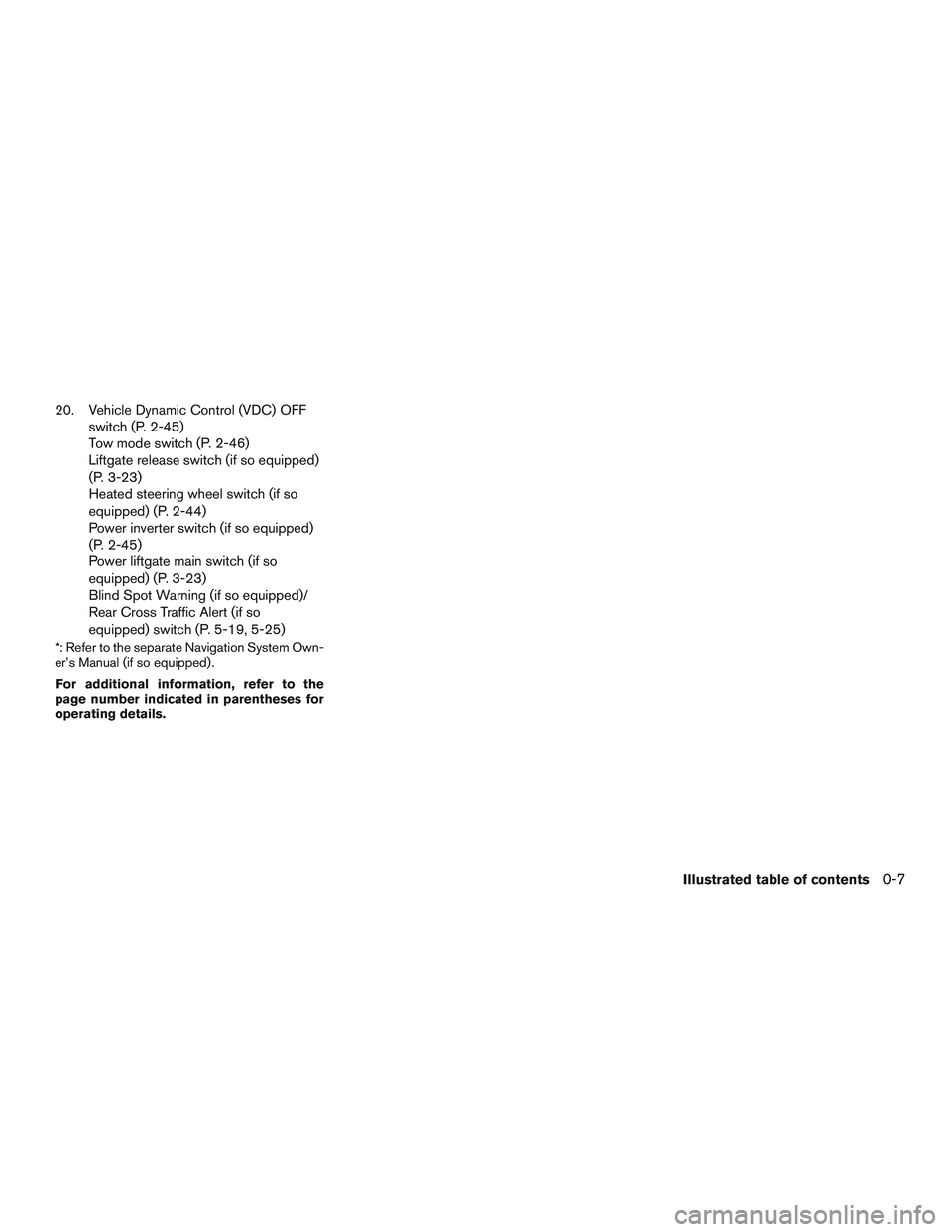
20. Vehicle Dynamic Control (VDC) OFF
switch (P. 2-45)
Tow mode switch (P. 2-46)
Liftgate release switch (if so equipped)
(P. 3-23)
Heated steering wheel switch (if so
equipped) (P. 2-44)
Power inverter switch (if so equipped)
(P. 2-45)
Power liftgate main switch (if so
equipped) (P. 3-23)
Blind Spot Warning (if so equipped)/
Rear Cross Traffic Alert (if so
equipped) switch (P. 5-19, 5-25)
*: Refer to the separate Navigation System Own-
er’s Manual (if so equipped) .
For additional information, refer to the
page number indicated in parentheses for
operating details.
Illustrated table of contents0-7
Page 83 of 524
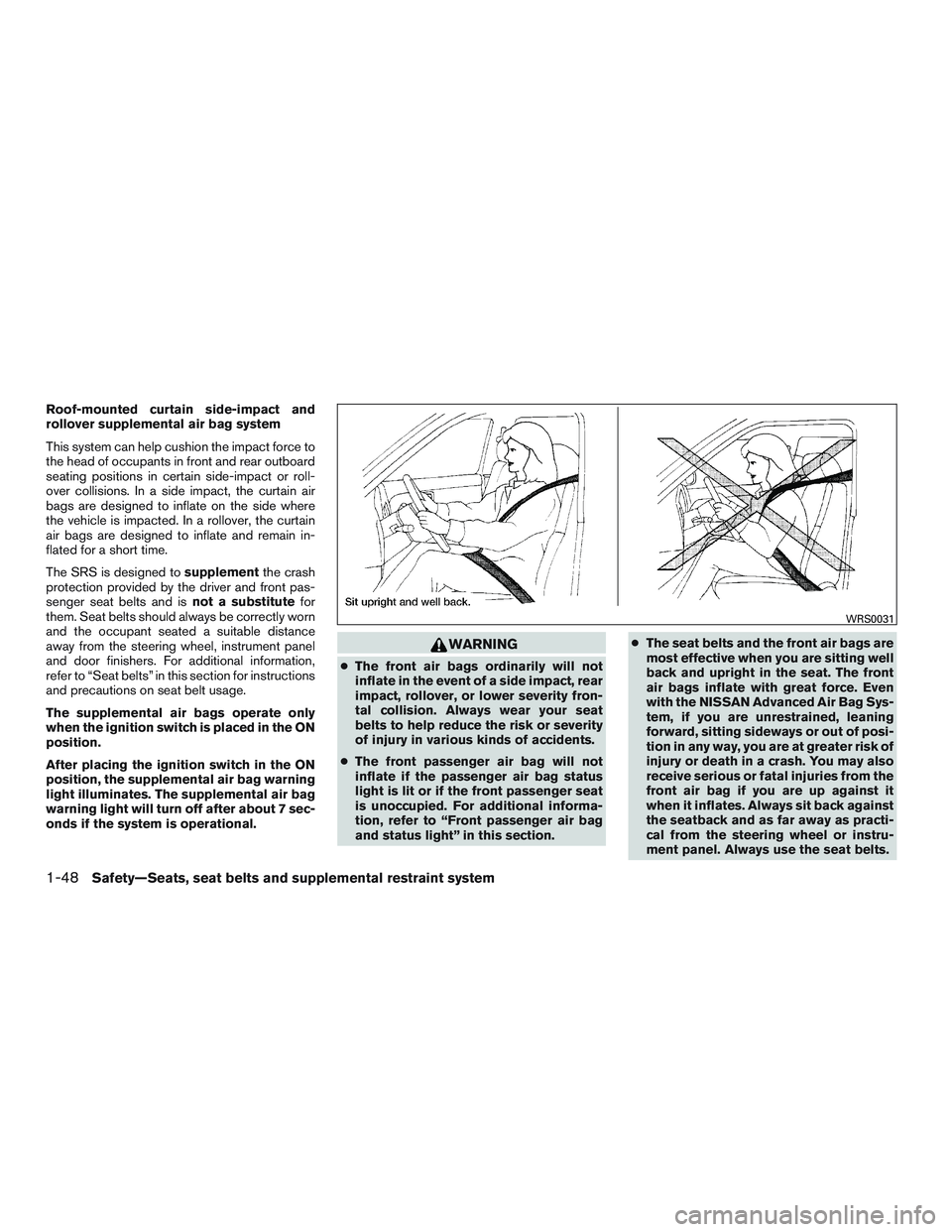
Roof-mounted curtain side-impact and
rollover supplemental air bag system
This system can help cushion the impact force to
the head of occupants in front and rear outboard
seating positions in certain side-impact or roll-
over collisions. In a side impact, the curtain air
bags are designed to inflate on the side where
the vehicle is impacted. In a rollover, the curtain
air bags are designed to inflate and remain in-
flated for a short time.
The SRS is designed tosupplementthe crash
protection provided by the driver and front pas-
senger seat belts and isnot a substitutefor
them. Seat belts should always be correctly worn
and the occupant seated a suitable distance
away from the steering wheel, instrument panel
and door finishers. For additional information,
refer to “Seat belts” in this section for instructions
and precautions on seat belt usage.
The supplemental air bags operate only
when the ignition switch is placed in the ON
position.
After placing the ignition switch in the ON
position, the supplemental air bag warning
light illuminates. The supplemental air bag
warning light will turn off after about 7 sec-
onds if the system is operational.
WARNING
●The front air bags ordinarily will not
inflate in the event of a side impact, rear
impact, rollover, or lower severity fron-
tal collision. Always wear your seat
belts to help reduce the risk or severity
of injury in various kinds of accidents.
●The front passenger air bag will not
inflate if the passenger air bag status
light is lit or if the front passenger seat
is unoccupied. For additional informa-
tion, refer to “Front passenger air bag
and status light” in this section.●The seat belts and the front air bags are
most effective when you are sitting well
back and upright in the seat. The front
air bags inflate with great force. Even
with the NISSAN Advanced Air Bag Sys-
tem, if you are unrestrained, leaning
forward, sitting sideways or out of posi-
tion in any way, you are at greater risk of
injury or death in a crash. You may also
receive serious or fatal injuries from the
front air bag if you are up against it
when it inflates. Always sit back against
the seatback and as far away as practi-
cal from the steering wheel or instru-
ment panel. Always use the seat belts.
WRS0031
1-48Safety—Seats, seat belts and supplemental restraint system
Page 84 of 524
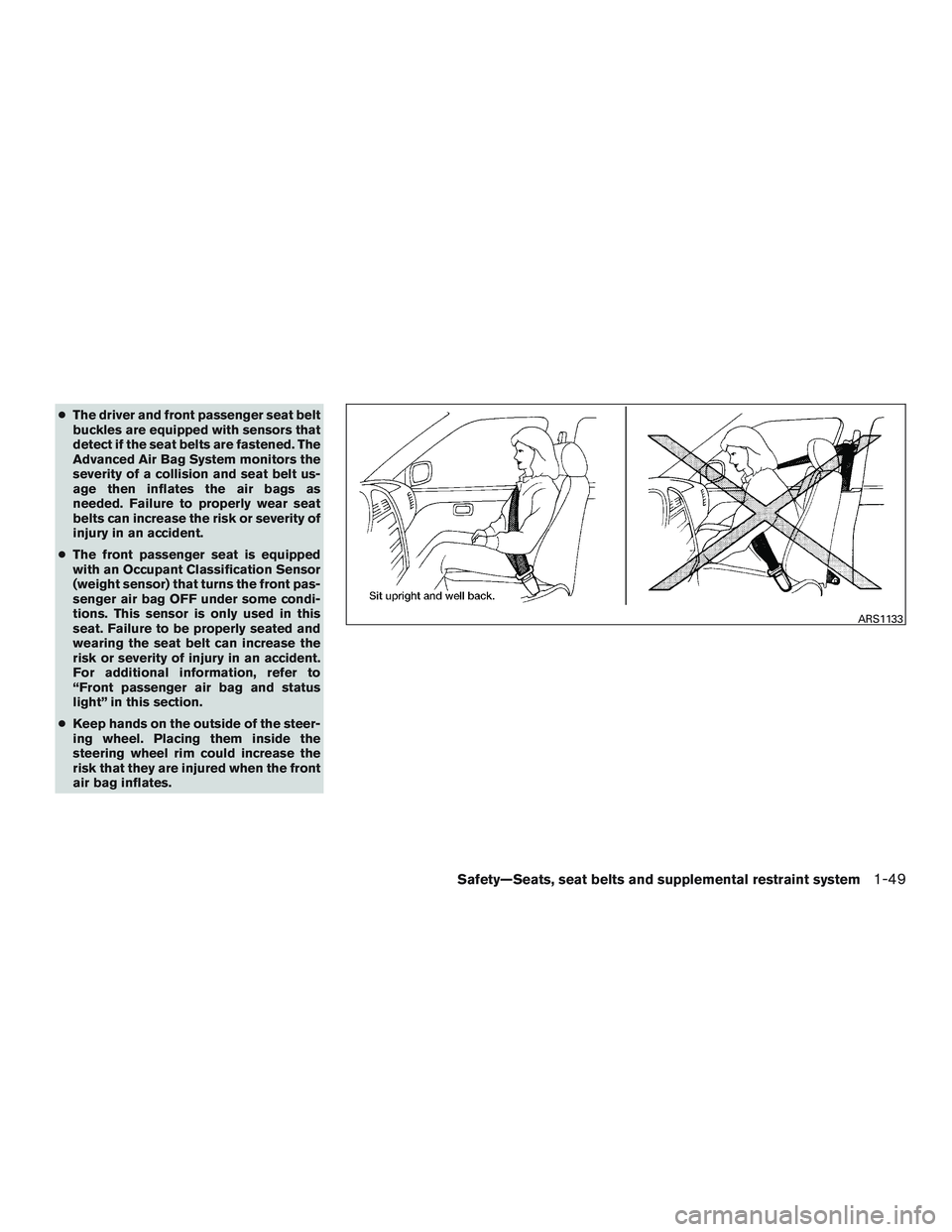
●The driver and front passenger seat belt
buckles are equipped with sensors that
detect if the seat belts are fastened. The
Advanced Air Bag System monitors the
severity of a collision and seat belt us-
age then inflates the air bags as
needed. Failure to properly wear seat
belts can increase the risk or severity of
injury in an accident.
●The front passenger seat is equipped
with an Occupant Classification Sensor
(weight sensor) that turns the front pas-
senger air bag OFF under some condi-
tions. This sensor is only used in this
seat. Failure to be properly seated and
wearing the seat belt can increase the
risk or severity of injury in an accident.
For additional information, refer to
“Front passenger air bag and status
light” in this section.
●Keep hands on the outside of the steer-
ing wheel. Placing them inside the
steering wheel rim could increase the
risk that they are injured when the front
air bag inflates.
ARS1133
Safety—Seats, seat belts and supplemental restraint system1-49
Page 90 of 524
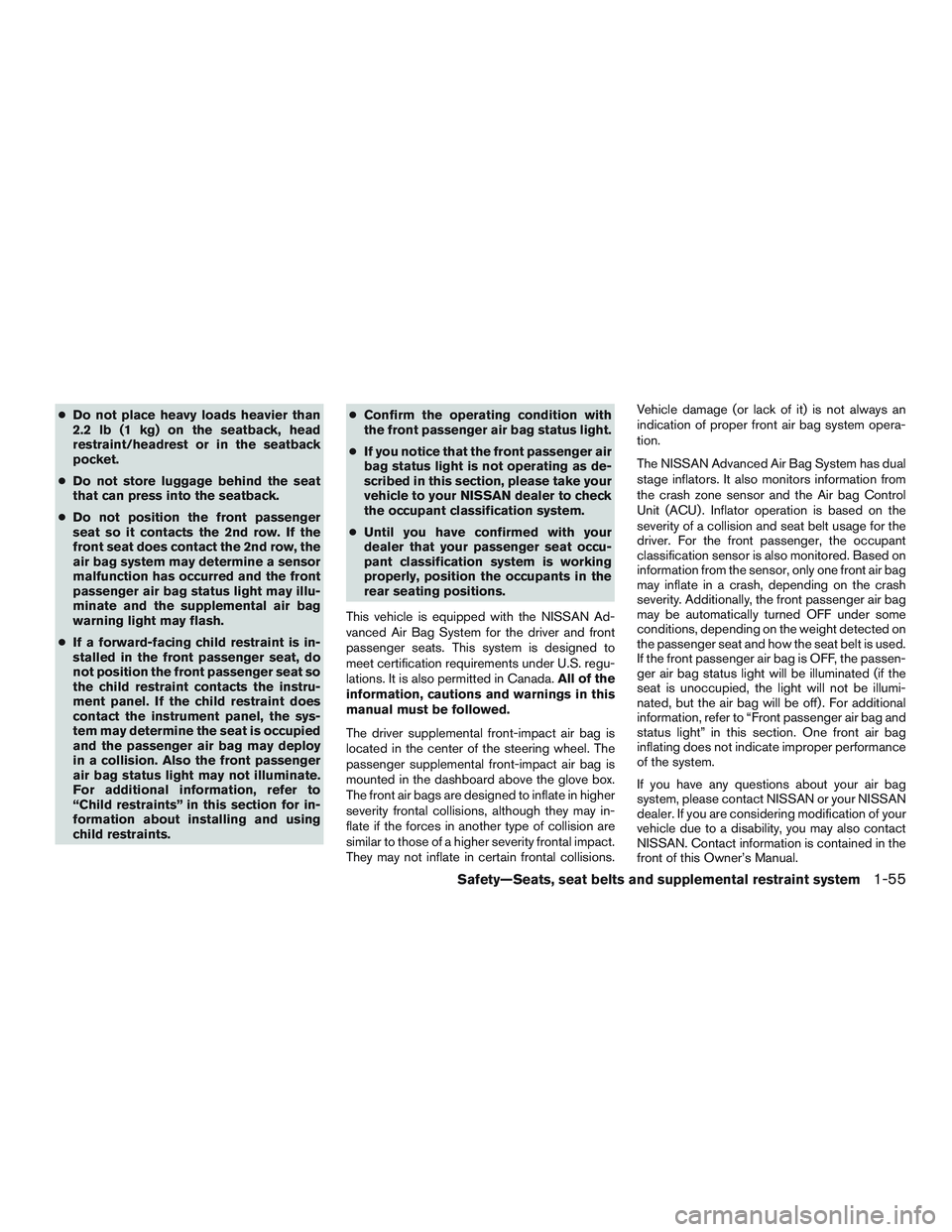
●Do not place heavy loads heavier than
2.2 lb (1 kg) on the seatback, head
restraint/headrest or in the seatback
pocket.
●Do not store luggage behind the seat
that can press into the seatback.
●Do not position the front passenger
seat so it contacts the 2nd row. If the
front seat does contact the 2nd row, the
air bag system may determine a sensor
malfunction has occurred and the front
passenger air bag status light may illu-
minate and the supplemental air bag
warning light may flash.
●If a forward-facing child restraint is in-
stalled in the front passenger seat, do
not position the front passenger seat so
the child restraint contacts the instru-
ment panel. If the child restraint does
contact the instrument panel, the sys-
tem may determine the seat is occupied
and the passenger air bag may deploy
in a collision. Also the front passenger
air bag status light may not illuminate.
For additional information, refer to
“Child restraints” in this section for in-
formation about installing and using
child restraints.●Confirm the operating condition with
the front passenger air bag status light.
●If you notice that the front passenger air
bag status light is not operating as de-
scribed in this section, please take your
vehicle to your NISSAN dealer to check
the occupant classification system.
●Until you have confirmed with your
dealer that your passenger seat occu-
pant classification system is working
properly, position the occupants in the
rear seating positions.
This vehicle is equipped with the NISSAN Ad-
vanced Air Bag System for the driver and front
passenger seats. This system is designed to
meet certification requirements under U.S. regu-
lations. It is also permitted in Canada.All of the
information, cautions and warnings in this
manual must be followed.
The driver supplemental front-impact air bag is
located in the center of the steering wheel. The
passenger supplemental front-impact air bag is
mounted in the dashboard above the glove box.
The front air bags are designed to inflate in higher
severity frontal collisions, although they may in-
flate if the forces in another type of collision are
similar to those of a higher severity frontal impact.
They may not inflate in certain frontal collisions.Vehicle damage (or lack of it) is not always an
indication of proper front air bag system opera-
tion.
The NISSAN Advanced Air Bag System has dual
stage inflators. It also monitors information from
the crash zone sensor and the Air bag Control
Unit (ACU) . Inflator operation is based on the
severity of a collision and seat belt usage for the
driver. For the front passenger, the occupant
classification sensor is also monitored. Based on
information from the sensor, only one front air bag
may inflate in a crash, depending on the crash
severity. Additionally, the front passenger air bag
may be automatically turned OFF under some
conditions, depending on the weight detected on
the passenger seat and how the seat belt is used.
If the front passenger air bag is OFF, the passen-
ger air bag status light will be illuminated (if the
seat is unoccupied, the light will not be illumi-
nated, but the air bag will be off) . For additional
information, refer to “Front passenger air bag and
status light” in this section. One front air bag
inflating does not indicate improper performance
of the system.
If you have any questions about your air bag
system, please contact NISSAN or your NISSAN
dealer. If you are considering modification of your
vehicle due to a disability, you may also contact
NISSAN. Contact information is contained in the
front of this Owner’s Manual.
Safety—Seats, seat belts and supplemental restraint system1-55
Page 91 of 524
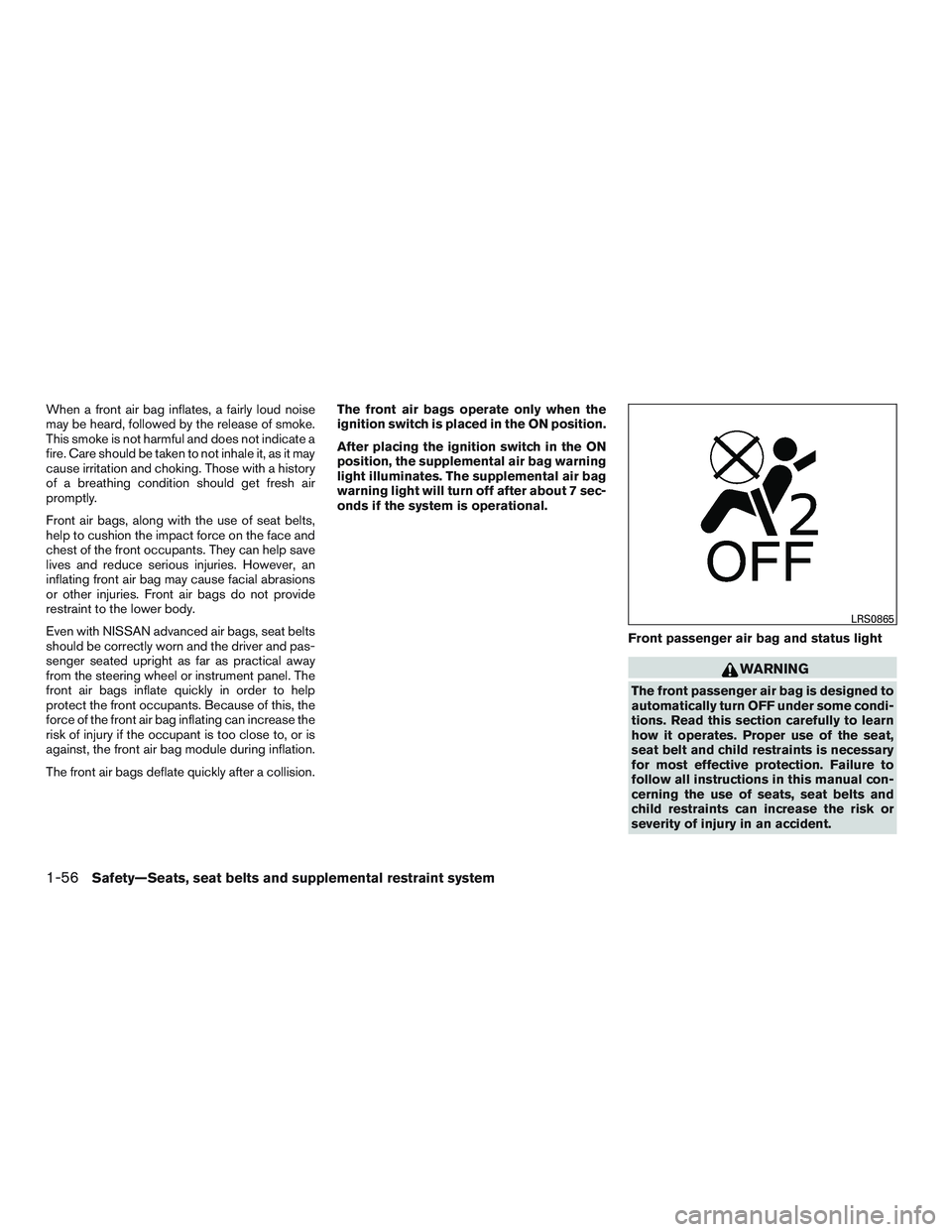
When a front air bag inflates, a fairly loud noise
may be heard, followed by the release of smoke.
This smoke is not harmful and does not indicate a
fire. Care should be taken to not inhale it, as it may
cause irritation and choking. Those with a history
of a breathing condition should get fresh air
promptly.
Front air bags, along with the use of seat belts,
help to cushion the impact force on the face and
chest of the front occupants. They can help save
lives and reduce serious injuries. However, an
inflating front air bag may cause facial abrasions
or other injuries. Front air bags do not provide
restraint to the lower body.
Even with NISSAN advanced air bags, seat belts
should be correctly worn and the driver and pas-
senger seated upright as far as practical away
from the steering wheel or instrument panel. The
front air bags inflate quickly in order to help
protect the front occupants. Because of this, the
force of the front air bag inflating can increase the
risk of injury if the occupant is too close to, or is
against, the front air bag module during inflation.
The front air bags deflate quickly after a collision.The front air bags operate only when the
ignition switch is placed in the ON position.
After placing the ignition switch in the ON
position, the supplemental air bag warning
light illuminates. The supplemental air bag
warning light will turn off after about 7 sec-
onds if the system is operational.
Front passenger air bag and status light
WARNING
The front passenger air bag is designed to
automatically turn OFF under some condi-
tions. Read this section carefully to learn
how it operates. Proper use of the seat,
seat belt and child restraints is necessary
for most effective protection. Failure to
follow all instructions in this manual con-
cerning the use of seats, seat belts and
child restraints can increase the risk or
severity of injury in an accident.
LRS0865
1-56Safety—Seats, seat belts and supplemental restraint system